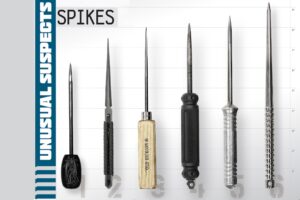Stab Vests: The Importance of Spike Protection
Written by: Robert Kaiser
You will no doubt be continually assessing your operational risk, in order to mitigate any identified risks sufficiently. But are you are aware of the growing risk from spikes or spiked weapons? Are you aware of the fact that certified spike protection cannot be guaranteed when purchasing stab vests?
Weapons like ice picks, shanks, sharpened screwdrivers, spiked clubs and strong hypodermic needles can indeed penetrate them if they are not offering specific, and more importantly, certified protection from this risk.

Interestingly, the need for spike protection was identified by prison and corrections officers, who were at serious risk from injury from spiked weapons. It was due to those operational risks and threats faced by the officers, that in the mid-1980s the California Department of Corrections issued an urgent requirement for all stab vests body armour to be tested against a commercial ice pick. The test method attempted to simulate the dynamics and force used by an attacker using a spike, intending to cause maximum harm or death.
However, society has changed, and some will argue not for the better. We all can clearly identify a global rise of knife crime and see a change in the type of edged weapons now being used on our streets. Many of which are spikes or makeshift spiked weapons, easy to hide, and often specifically engineered to enter another person’s body using minimum effort, with little or often no resistance.
From the body armour technology point, these spikes or shanks are exceptionally difficult to protect from. It is for this reason that not many stab vests or body armour are being officially certified with the prestigious SP1 (Spike Protection) rating.
In the UK, the Home Office Centre for Applied Science and Technology (CAST) is a highly regarded leader in stab and spike protection test protocols and standards.CAST highlight very clearly how spike protection can be attained, and it is worth pointing out that spike protection is only tested in combination with stab protection. It means a KR1 stand alone stab vest does NOT offer any quantifiable spike protection, unless it has also been tested and certified to SP1. A KR1 stand alone (without SP1) stab vest offers knife protection… and knife protection only. The spike protection level of a KR1 stand alone stab vest is in simple terms ‘unknown’ or ‘questionable’.
When it comes to stab vests or other types of body armour, it really is extremely important to understand that they are very particular in the kind of threats they protect against. Stab vests without certified spike protection can indeed be useless in the event of an attack using some of the truly horrific spiked weapons violently pointed at (or used) against our private security professionals here in the UK today.
I strongly suggest that if the environment, your operational responsibilities, or your situation requires knife protection, spike protection must also be deemed necessary.
All stab vests supplied by PPSS Group are certified to both KR1 knife protection and SP1 spike protection.
The Police Protective Equipment Database holds information on our protective equipment as it has met the test requirements and standards of the Home Office. You can search by equipment type, model number or test reference.
Please contact us if you wish to speak with us. Technical Director Colin Mackinnon (27 years with UK police, Counter Terrorism, Surveillance, Covert Ops and Firearms) would be more than happy to visit you at your facility.